First Plantings: Tomato and Pepper Plants
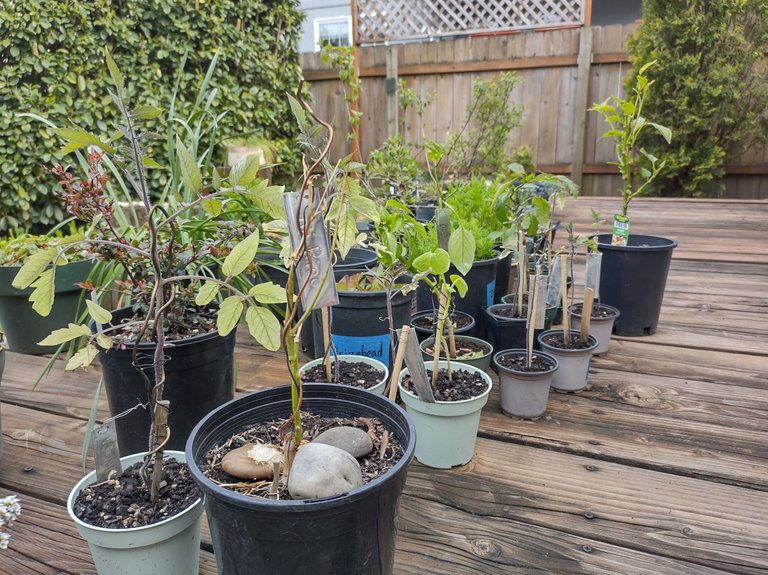
So many warm, wet, cloudy nights. For hardening off my seed grown tomato and pepper plants, the last few weeks have been a blessing.
Around the end of March I decided to plant out my hardiest plants into the garden.
Check out the results in my photos below.
Digging
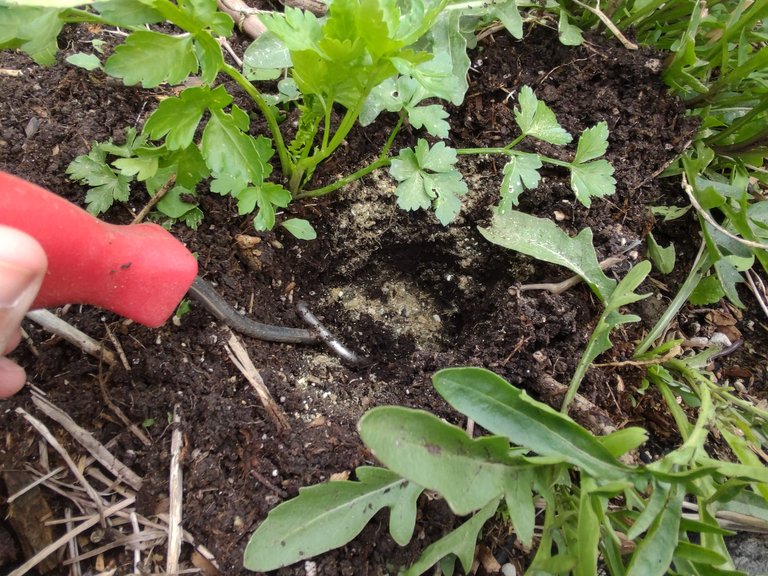
My garden soil is very soft this year, feels like cake mix.
I dig down deep to cover approximately 1/3 the base of the tomato stem. For the peppers, I only dig a little extra to make sure the surface roots are well mulched.
Add a few dashes of Dr. Earth's dry fertilizer, and call it good.
Layout
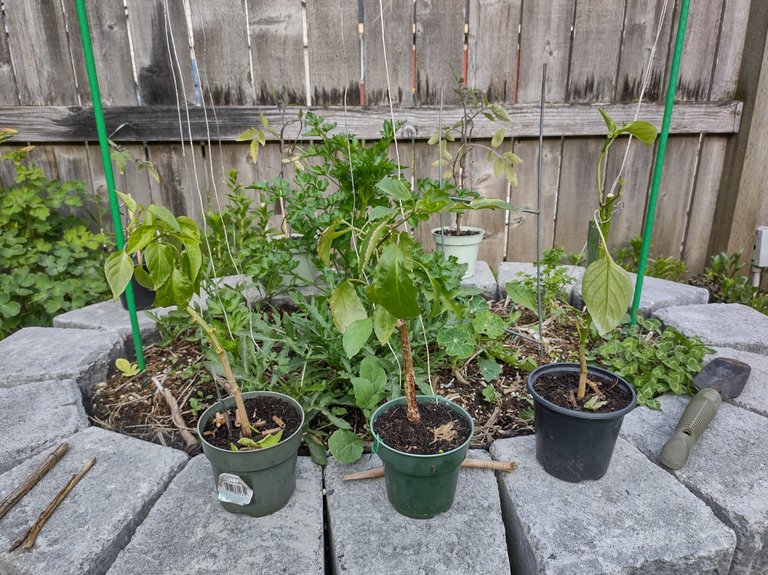
Earlier in the season I planned out how many planting locations I wanted for the tomatoes and peppers in this bed, by poking a wire in each spot where a hole will be dug for them.
Looking back, this was a brilliant plan. I tend to direct sow various cold tolerant veggie seeds in this same bed, yet many of them are now still germinating hidden under the surface. Knowing that most of my seeds were sown around, and not over my markers, means I can dig without worrying I am disturbing anything.
This year the general plan is to plant things closer together, to create a more protective green canopy to shade the soil by the time Summer becomes scorching hot.
#Peppers grow low and slow, yet withstand hot sun the best, so I am saving the front row for them. The #tomatoes love the sun too, but prefer cooler, wetter #roots, so I am putting them in the back and center where they can spread out and upward.
In the morning, the peppers will get the sun first, so they can shade the #soil behind, allowing morning dew to soak in. At noon, the tomatoes will shade lower young plants and roots from heat stress. In the evening, the sun dips behind the fence, allowing the tallest plants to gather more energy, while allowing shade to cool the soil.
Transplanting

When transplanting, the peppers always pop out of the #planters so cleanly. The roots of peppers are fragile and brittle, but tend to grip more of the soil together thanks to their rubbery cuticle, an adaptation of their doubt tolerance.
Tomatoes on the other hand, if you don't use a soil that is very fibrous, and too crumbly, well... it doesn't always come out in one piece. Especially if the soil is very wet and sticky, the soil and roots tend to stick badly to the bottom of the planter, making it hard to keep everything solid when excavating.
Yeah, you're supposed to be able gently tap, shake, and squeeze the plastic pot to release the rootball, but I am no perfectionist plant whisperer, such as Charles Dowding. I always end up doing that and holding the plant upside down doing upside-down surgery with muddle pokey tools, frustrated as hell when the rootball tears into a pile of dirt clods.
As I was struggling with the tomatoes, I came up with an idea for my ceramics class. I should build some clay circular tiles with drainage holes to put in the base of my #tomato pots. That way when they are ready to transplant (next year!) I can use a chopstick to pop out the tile and soil in one solid hunk with less mess or root injury.
Super Gardening Tip!
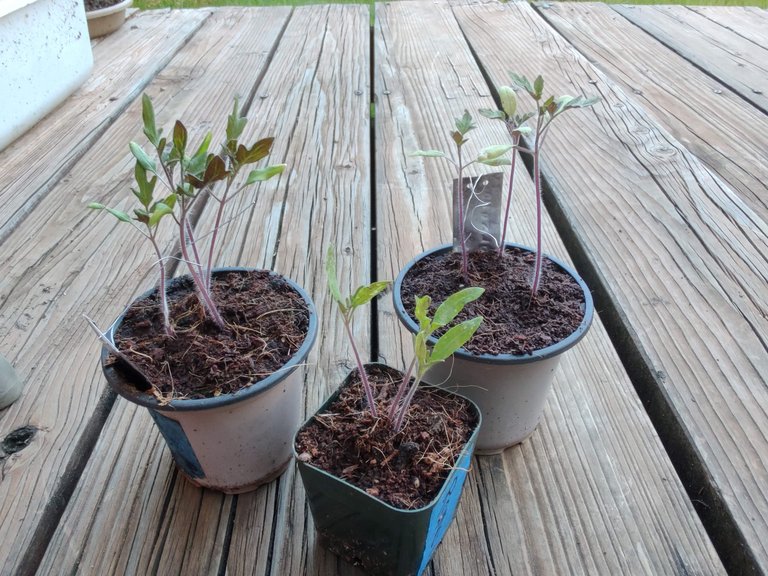
Update: Another solution to the heart of the tomato plant rootball dilemma I discovered, is to sow the seeds in clusters of two, three, or four.
Not only will the roots get a more sturdy grip on all of the soil, they will also regulate water absorption better, and the stems will also grow more upright as they support each other. Less leggy and more sturdy is always good!
My experience by growing them this way demonstrated that they also protect each other from wind and sun when hardening off outside.
Good solution for limited space gardeners with extra seeds. You could also use your less expensive seeds to help support expensive/delicate plants.
Snip away any unwanted plants after transplanting instead of separating them, and your plants will look like they were grown by a pro!
Final Touches
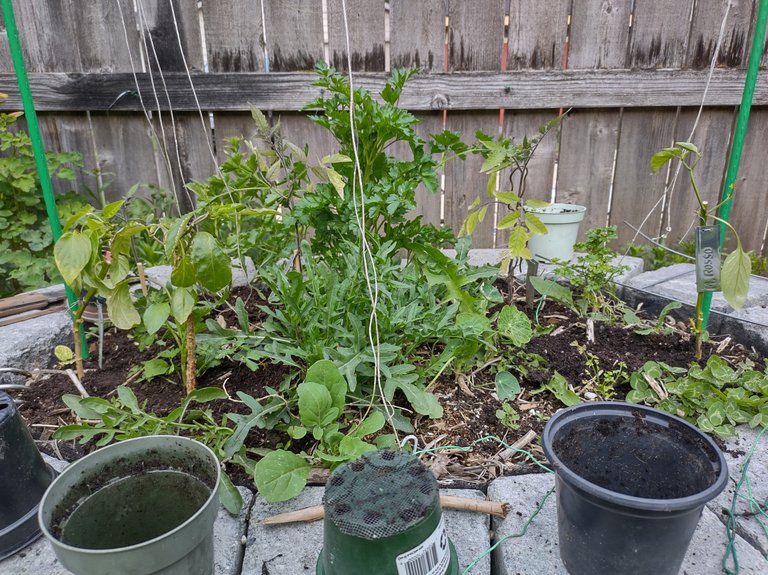
After each plant has been planted, I keep them attached to their stake and wire, and adjust things a bit so they are standing more straight and tall.
The thin aluminum wires I found were very useful for more delicate plants because it is soft and flexible.
My thicker gauge aluminum bonsai wire I am gambling that it won't injure my thicker plants, so long as it lightly surrounds, and doesn't squeeze the stem.
Wooden stakes are also very helpful. It prevents animals and weather from tipping over the plants.
Everything has a metal tag, so I will know what variety it is from seed to harvest.
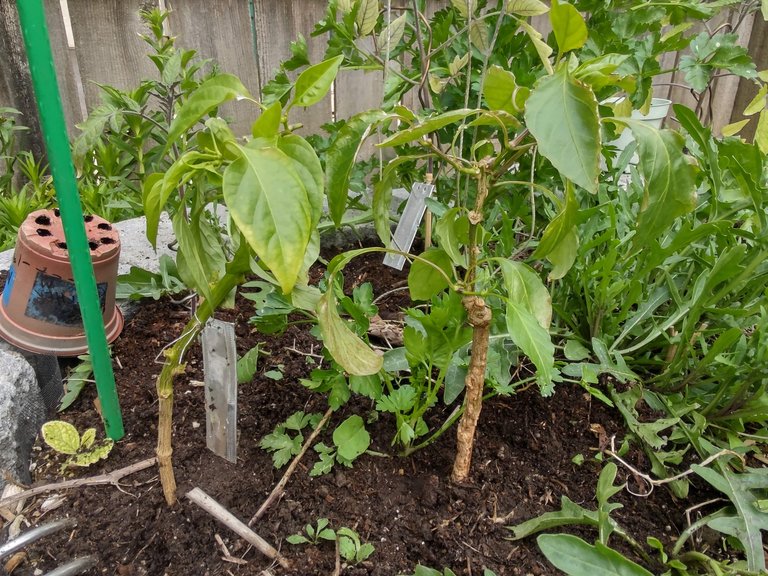
... Almost everything. I still have this one oddball unmarked pepper plant that survived two past years. It has quite a thick wood bark on it now.
Peppers grow a bark like this when brought indoors, called overwintering. It is very tricky to keep peppers alive when changing its soil, temperature, and climate so drastically. The key is to keep as much healthy green plant growth as possible. Too much dieback and it develops a thick bark where nothing new can grow from.
Next year, when I prepare the peppers for #overwintering, I might try bare rooting all my pepper plants, and putting them into a fresh soil of sphagnum moss, coir, and peat. They will go into stress when dug up, no matter what, but at least I can eliminate the pill bugs and fungus gnats that will attack it in winter.
Final Design

With everything planted, you can see where everything stands. I still have some wire markers in place where more tomato and pepper plants will be planted after Mother's Day. The other plants need to grow a bit stronger, and will benefit from the warmer soil temps.
Around the tomatoes I have some monstrous clumps of #Parsley growing, and some smaller sprouts of #arugula. These exist to confuse and distract pests, attract predatory wasps.
Having established plants nearby helps in many other ways. Animals cannot dig up the root filled soil as much, the stems breaks the wind and hold up nearby drooping plants on days of downpour and hail, and tall leaves dapple the light and provide a moisture rich #micro-climate so the air isn't suddenly hot if weather changes from rain to full sun.
Sprouting nearby, I may also find other things direct sown, like #clover, #radish, #spinach, #zinnia, #basil, #nasturtium, and borage to act as companion plant, harvestable crops, and beneficial garden flowers.

An old bent up steel wire stand, used for a sidewalk political poster, I salvaged to act as a ladder to help the tomatoes to grow up along.
This plastic cage, of my own making deters the mysterious nocturnal critters that tend to sniff out distressed soil and dig up my hard work. I have to be extremely careful when placing it, and removing it, since it tends to catch and pull at the edge of my plants, but it does give me insurance that nothing can ruin my hard work of the last four months of tending these seedlings.
Raddichio

In my front garden I want to end, by sharing this photo of my #raddichio plant. It has large red winter leaves.
I think they look delicious, but I want it to continue to grow deeper and stronger and maybe even flower, so I can have a bigger bounty for next year.
Raddichio is sort of fussy to become established until it gets deep roots under the clay rich soil it loves as it matures. If I can develop a self-replenishing crop people enjoy, then that will be an achievement of superior land management and stewardship.
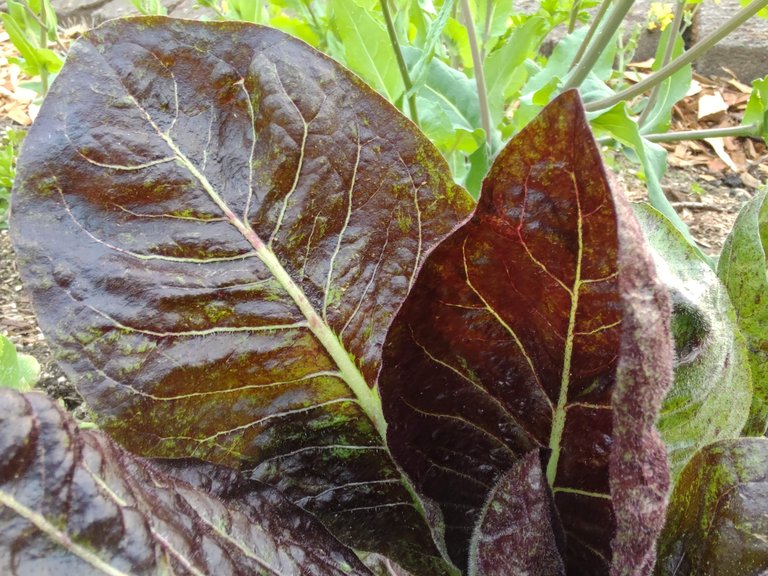
#hardening-off #charles-dowding #garden-planning
Post Beneficiaries:
- 1% @cryptopie
This is my way of thanking each of you for your friendship and support. By sharing my talents on Hive, I can also share to help with your needs.
Let my success also grant you some happiness too.

Raddichio looks lovely 🙂 Took me awhile to get through your post this morning due to detour to Charles Dowding. I love the thorough planning of space. And I expected some expert plant support from a bonsai enthusiast. Hopefully our garden will progress season over season. Right now we have lots of enthusiasm. In future years, expereince will come. We started pepper plants from seeds. How old are your pepper plants? do they produce in one season? btw love the ceramic tile idea for tomato seedlings
The peppers are going in their second season, and a few into their third season.
Isn't Charles interesting? I could listen to his neighborly voice for hours talk about gardening.
I am going to copy this technique of yours in securing my future crops. Good afternoon!
Awesome! Hope it works out well for you.
Hope they do well and your cage works!